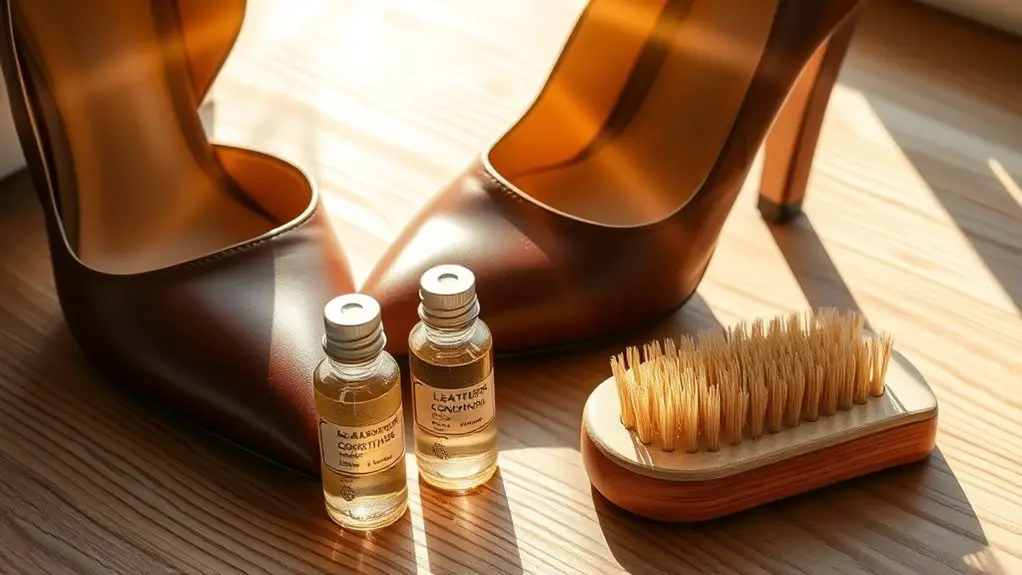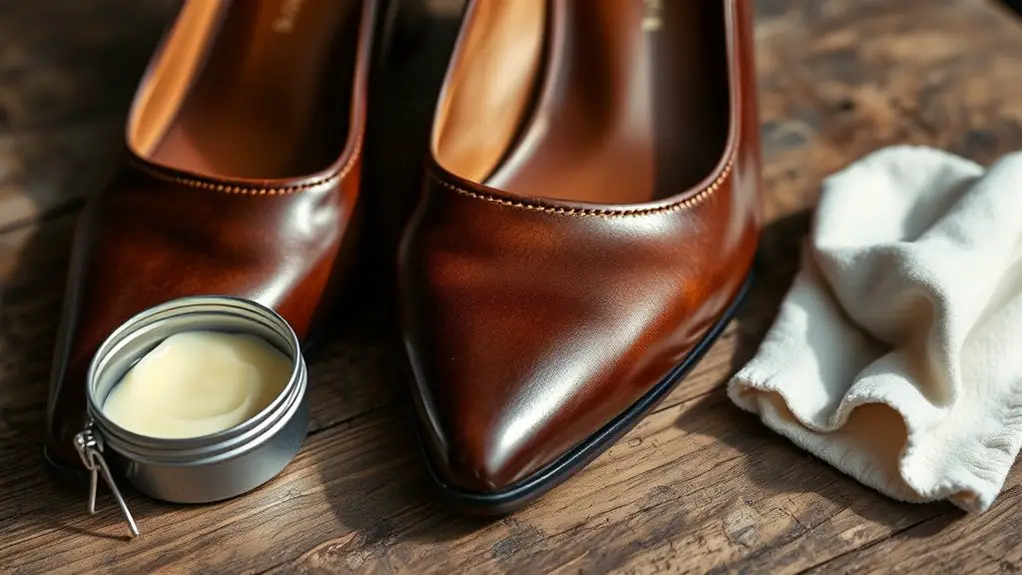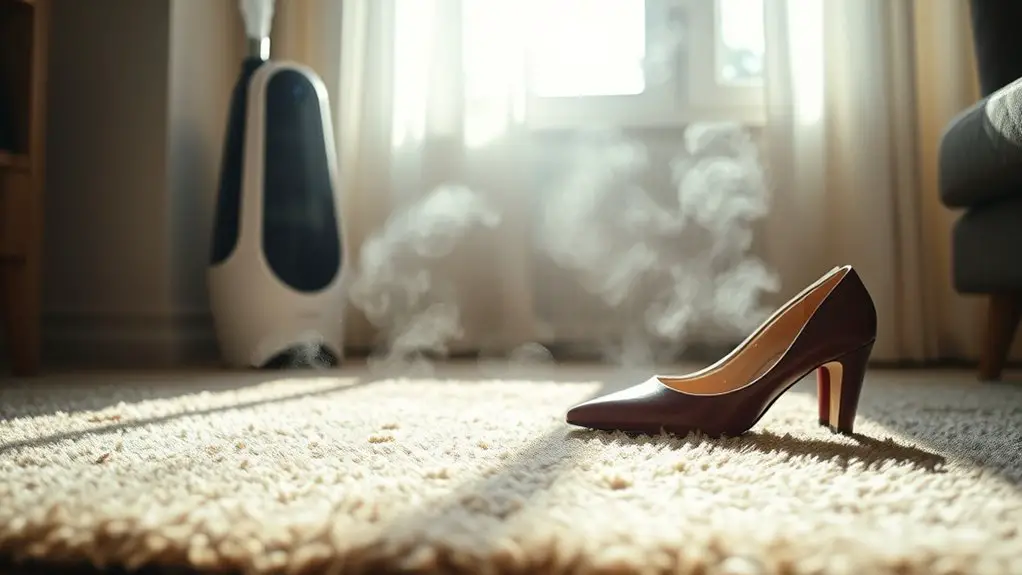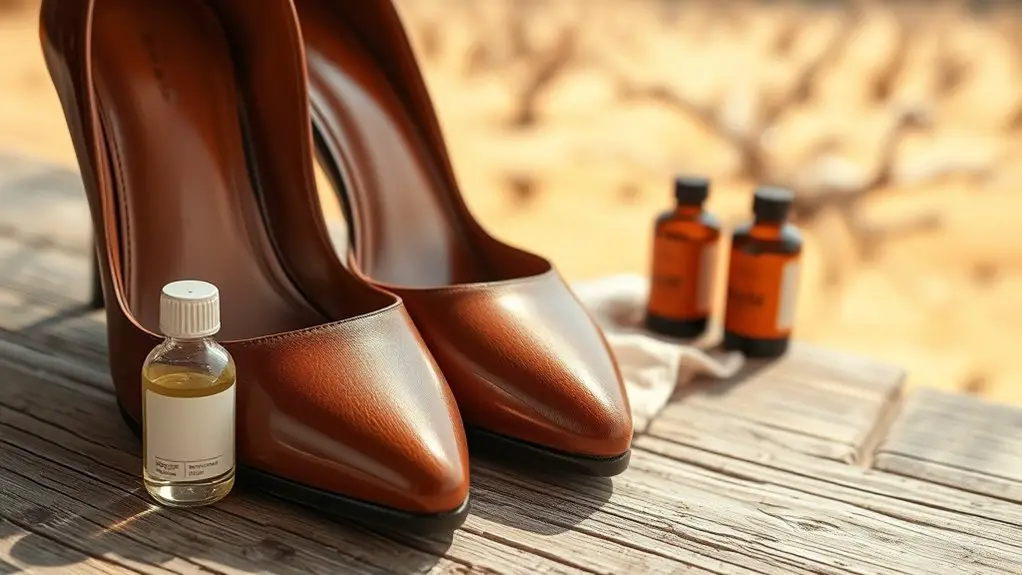To keep your leather heels from cracking in dry climates, choose durable materials like full-grain leather. Regularly clean them with mild soap and a damp cloth, and condition every three to six months to replenish lost moisture. Store your heels in a cool, dry area away from direct sunlight, using shoe trees to maintain their shape. Protect them with breathable water-resistant sprays. By following these steps, you can enhance their longevity, and there’s even more to explore on proper care.
Understanding the Effects of Dry Climate on Leather

When you live in a dry climate, it’s vital to understand how it affects leather materials, especially your beloved heels. The low humidity can greatly impact leather durability, causing it to lose moisture and become brittle over time. This loss of hydration leads to cracks and creases, which not only detracts from the aesthetic but can also compromise the structure of your shoes.
To mitigate these climate effects, regular conditioning is essential. Use a high-quality leather conditioner that replenishes moisture and keeps the material supple. Additionally, store your heels in a cool, dark place, away from direct sunlight, which can exacerbate drying. Avoid wearing them in extremely dry conditions for extended periods, as this can hasten deterioration. By taking proactive measures to protect your leather heels, you’ll guarantee they remain stylish and functional for years to come, despite the challenges posed by your environment.
Choose the Right Leather for Your Heels
Choosing the right leather for your heels plays a significant role in their longevity, especially in dry climates. Start by considering the leather types available. Full-grain leather is durable and ages beautifully, making it a great choice for heels. Top-grain leather, while slightly less durable, is softer and more pliable, offering comfort. Avoid using suede or nubuck, as they tend to absorb moisture and can crack more easily in arid conditions.
When selecting heel materials, think about how they complement the leather. Wood or rubber soles can provide better shock absorption, reducing stress on the leather itself. Confirm that the heel structure is solid, as this also impacts the overall longevity of the shoes. By choosing high-quality leather types and sturdy heel materials, you’ll create a solid foundation for your heels, helping to prevent cracking and confirming they last through many dry seasons.
Regular Cleaning and Maintenance

To keep your leather heels in top shape, regular cleaning is essential. Use a mild soap and a damp cloth to gently wipe away dirt and grime, preventing buildup that can lead to cracking. Additionally, conditioning the leather every few months will maintain its suppleness and protect it from drying out.
Clean With Mild Soap
One effective way to maintain your leather heels and prevent cracking is by incorporating regular cleaning with mild soap into your routine. Start by mixing a few drops of mild soap with warm water. Dampen a soft cloth in the solution, ensuring it’s not overly wet, then gently wipe down your heels to remove dirt and grime. This process not only cleans but also helps to lift away harmful salts and oils that can cause damage. After cleaning, use a dry cloth to remove excess moisture. Remember, regular leather care is essential, so aim to clean your heels every few weeks, especially if you wear them often. This simple step can greatly extend the life of your beloved leather heels.
Condition Leather Regularly
While regular cleaning is essential for maintaining your leather heels, conditioning them is equally important to prevent cracking and keep the leather supple. Conditioning provides necessary leather nourishment by replenishing oils that can be lost over time, especially in dry climates. Look for a high-quality leather conditioner specifically designed for footwear. Apply it every few months or more frequently if you notice dryness.
Before conditioning, make certain your heels are clean and free of dirt. Use a soft cloth to apply the conditioner evenly, focusing on creased areas where moisture retention is vital. Allow it to absorb fully before wearing. By incorporating this simple step into your routine, you’ll extend the life of your leather heels and keep them looking vibrant.
Conditioning Your Leather Heels
Conditioning your leather heels is essential for preventing cracks and maintaining their appearance. You’ll want to choose the best conditioning products that nourish the leather without causing damage. Understanding proper application techniques can make a significant difference in how effectively your heels retain their softness and flexibility.
Importance of Conditioning
If you want to extend the life of your leather heels, regularly conditioning them is essential. Conditioning helps maintain leather longevity by preventing it from drying out and cracking, particularly in dry climates. When you condition, you’re replenishing the natural oils that leather loses over time. It’s a good idea to establish a conditioning frequency; generally, every three to six months is effective, depending on how often you wear your heels and the climate conditions. Pay attention to the signs of dryness, like stiffness or visible cracks, which indicate it’s time to condition. By committing to this simple routine, you’ll keep your leather heels looking fresh and vibrant, ensuring they serve you well for years to come.
Best Conditioning Products
To keep your leather heels in top shape, selecting the right conditioning products is vital. For effective leather care, consider using a high-quality leather conditioner. Look for products that contain natural oils, like mink oil or neatsfoot oil, to deeply nourish and moisturize the leather. Cream-based conditioners often provide excellent hydration and can restore your heels’ suppleness. Product recommendations include brands like Lexol or Saphir, known for their reliable formulations. If you prefer a spray option, try a water-based conditioner that won’t leave a greasy residue. Always check for compatibility with your specific leather type to guarantee ideal results. With the right products, you’ll keep your heels looking great and prevent cracking in dry climates.
Application Techniques Explained
Applying conditioner to your leather heels is a straightforward process that can greatly extend their life and maintain their appearance. Begin by selecting an appropriate leather conditioner and gather your supplies: a clean cloth and a soft brush. For application methods, start with the brush to remove any dirt or dust. Then, use the cloth to apply a small amount of conditioner, working it into the leather using gentle circular motions. Focus on seams and areas prone to cracking. Allow the conditioner to absorb for about 15-20 minutes, then buff with a clean cloth for a polished finish. Regularly using these conditioning techniques will help keep your leather heels supple and prevent damage caused by dry climates.
Storing Your Heels Properly
While you might think tossing your leather heels into the closet is fine, proper storage is essential for maintaining their condition. To avoid cracking, follow these tips for effective shoe storage:
Proper storage is key to keeping your leather heels in top shape and preventing cracking.
- Maintain an Ideal Temperature: Keep your heels in a cool, dry place—ideally between 60-75°F—to prevent damage.
- Use Shoe Trees: Insert cedar or plastic shoe trees to help maintain their shape and prevent creasing.
- Avoid Direct Sunlight: Store your heels away from sunlight to avoid fading and drying out the leather.
- Keep Them Clean: Wipe off dirt and dust before storing; this helps preserve the leather’s natural oils.
Using Humidifiers in Your Home

Using a humidifier in your home can greatly improve the longevity of your leather heels, especially in dry environments. Keeping ideal humidity levels in your living space prevents leather from losing moisture, which can lead to cracks. Humidifiers benefits include maintaining a balanced atmosphere that protects not just your shoes but also your skin and furniture. By adding moisture to the air, you create a more comfortable environment that helps prevent the leather from drying out.
Consider placing a humidifier in the room where you store your heels. Aim for humidity levels between 40-60% for the best results. Regularly check your humidifier to verify it’s functioning properly, and clean it to avoid mold buildup. This small investment can save you costly repairs or replacements down the line. Remember, maintaining adequate humidity can greatly extend the life of your cherished leather footwear.
Avoiding Excessive Heat Exposure
Humidity control is just one aspect of caring for your leather heels; protecting them from excessive heat is equally important. Heat damage can cause your heels to dry out and crack, especially during temperature fluctuations. Here are some practical tips to avoid excessive heat exposure:
Proper care for leather heels includes protecting them from heat to prevent drying and cracking.
- Store your heels in a cool, dry place: Avoid direct sunlight or heat sources like radiators.
- Don’t leave them in your car: The interior can reach extreme temperatures, leading to irreversible damage.
- Use shoe bags or boxes: These can protect your heels from heat and dust.
- Limit exposure to hot air: When using hairdryers or heaters, keep your heels away from the airflow.
Protecting Your Heels With Water-Resistant Sprays
To keep your leather heels looking pristine and prevent damage from water, applying a water-resistant spray is a smart move. There are several water-resistant options available specifically designed for leather. When choosing a spray, look for one that’s breathable and won’t alter the color or texture of your heels.
Before spray application, clean your shoes to remove dirt and oils; this helps the spray adhere better. Hold the spray about six inches away from the surface and apply an even coat, ensuring you cover all areas, including seams and edges. Allow the spray to dry according to the manufacturer’s instructions, typically about 15 minutes, before wearing them.
Reapply every few weeks, especially in dry climates, to maintain protection. This simple practice can notably extend the life of your leather heels and keep them looking fabulous, even in challenging conditions.
When to Seek Professional Help
Although you might take great care of your leather heels, there are times when professional help is necessary to address issues that you can’t fix at home. Knowing when to seek professional repair can save your shoes from further damage. Here are some signs that it’s time to consult leather specialists:
- Deep Cracks: If you notice deep cracks that appear despite regular conditioning, it’s time for a professional.
- Separation: When the sole starts to separate from the upper, a specialist can reattach and strengthen the bond.
- Stains: For stubborn stains that won’t budge, a leather specialist has the right tools and products to restore your heels.
- Deformation: If your heels have lost their shape, professional repair can reshape and reinforce them.
Frequently Asked Questions
Can I Wear Leather Heels in Humid Climates?
Yes, you can wear leather heels in humid climates. However, humidity effects can cause discomfort, so choose breathable designs. Guarantee proper fit and consider moisture-wicking socks to maintain heel comfort and prevent slipping.
How Often Should I Condition My Leather Heels?
To maintain your leather heels, you should condition them every 3 to 6 months, depending on usage. Regular leather care prevents dryness, preserves flexibility, and enhances longevity, ensuring your heels remain stylish and comfortable longer.
Are There Specific Brands for Leather Heel Care Products?
For leather heel care, some of the best brands are Saphir, Lexol, and Bickmore. These companies offer excellent product recommendations like conditioners and protectants that’ll help maintain your leather’s suppleness and longevity effectively.
Can I Repair Cracked Leather Heels Myself?
While you might think repairing cracked leather heels is challenging, DIY leather repair’s possible! With proper leather care techniques, you can use specialized products to restore their beauty, ensuring they’ll last longer and look great again.
What Types of Leather Are Most Resistant to Cracking?
When considering leather types, full grain leather’s durability and breathability make it highly resistant to cracking. Suede leather, while softer, can also withstand some wear, though it’s less robust than full grain in harsh conditions.



